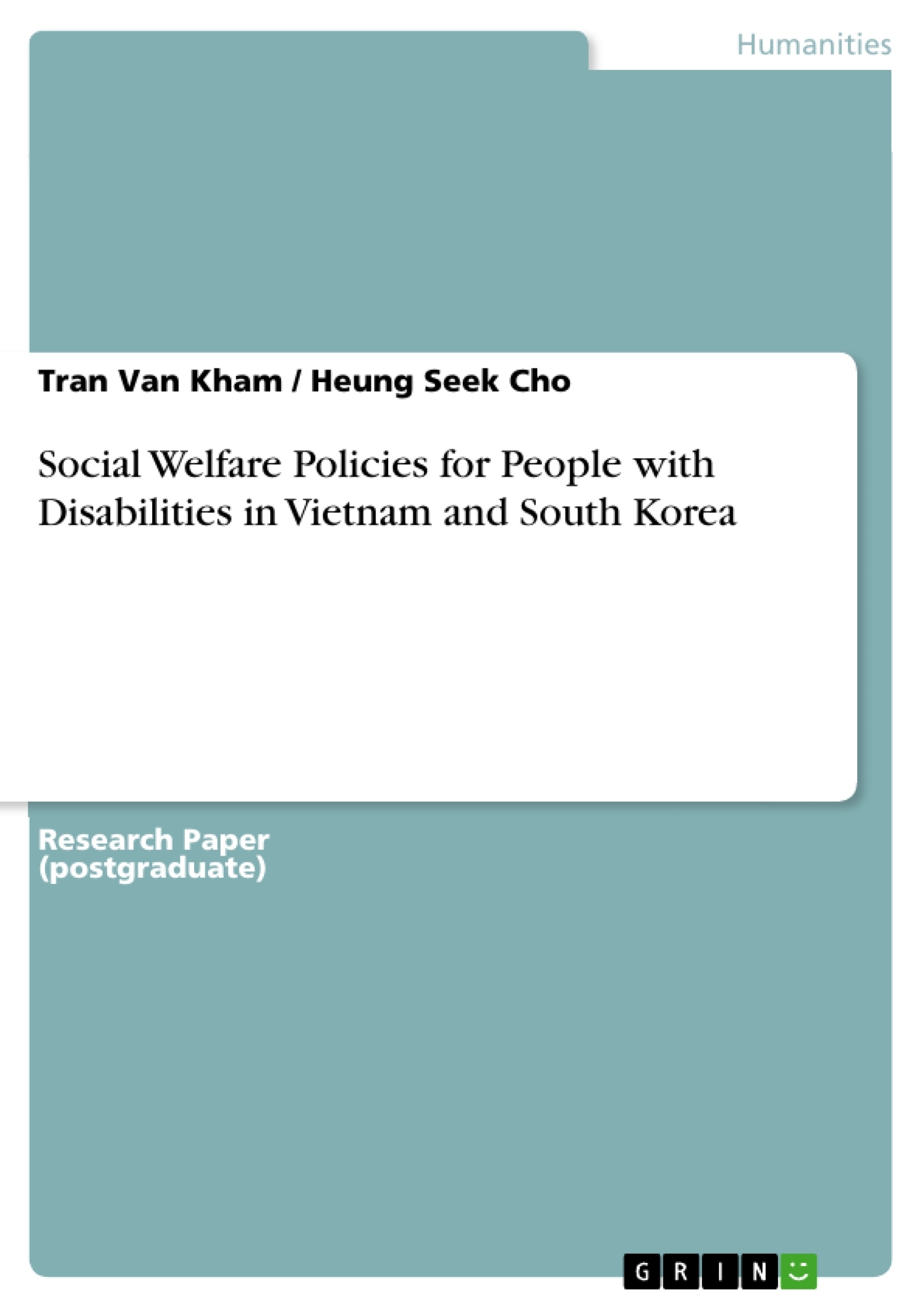Since the United Nations' Convention on the rights for disabled people approved in 2006, the understanding of disability and support for people with disabilities worldwide has changed and progressed sustainably. That includes the changes in theoretical debates and welfare policy on disability to encourage society to understand and treat people with disability as other citizens. However, people with disabilities in Vietnam and Korea still experience the difficulties and need further support.
This paper looks and compares the welfare initiatives in Vietnam and South Korea on supporting the people with disabilities in order to articulate some of implicit values of welfare practices for people with disabilities in these contexts and to make the experiences to each other.
Inhaltsverzeichnis (Table of Contents)
- Abstract
- Keywords
- 1. Introduction
- 2. Current population trend of people with disabilities
- 2.1. People with disabilities in South Korean
- 2.2. People with disabilities in Vietnam
- 3. Related welfare laws for people with disabilities
- 3.1. Related welfare laws for people with disabilities in South Korea
- 3.2. Related welfare laws for people with disabilities in Vietnam
- 4. Welfare policies for people with disabilities
- 4.1. Welfare policies for people with disability: South Korea’s case
- 4.1.1. Disabled income security policy in South Korea
- 4.1.2. Disabled Employment policy in South Korea
- 4.1.3. Disabled health insurance in South Korea
- 4.1.4. Education Policy for Disabled in South Korea
- 4.2. Welfare policies for people with disability: Vietnam’s case
- 4.2.1. Disability allowance
- 4.2.2. Education
- 4.2.3. Vocational training and employment
- 4.2.4. Health care
- 4.2.5. Social supports and social assistance
- 4.2.6. Cultural and sport activities
- 4.2.7. Transportation and public accessibility
Zielsetzung und Themenschwerpunkte (Objectives and Key Themes)
This paper aims to analyze and compare the implementation of welfare policies for people with disabilities (PWD) in Vietnam and South Korea. By examining policies related to education, employment, health, and income, the study aims to identify implicit values of welfare practices in these contexts and share experiences between the two countries. The paper seeks to identify strategies that the Vietnamese government can adopt from the South Korean government to strengthen its welfare state and support for PWD.
- Comparison of welfare policies for PWD in Vietnam and South Korea
- Identification of implicit values embedded in welfare practices for PWD
- Analysis of the effectiveness of implemented policies in both contexts
- Exploration of strategies for enhancing Vietnam's welfare state and support for PWD
- Examination of the social model of disability and its application in both countries
Zusammenfassung der Kapitel (Chapter Summaries)
Chapter 1: Introduction
This chapter establishes the context for the study by highlighting the challenges faced by PWD in both Vietnam and South Korea. It emphasizes the importance of improving their living standards through government-established insurance policy systems. The study focuses on the dimensional analysis model of social welfare policy, specifically employing the basic framework model developed by Gilbert and Terrell (1992).
Chapter 2: Current population trend of people with disabilities
This chapter presents a demographic overview of PWD in South Korea and Vietnam. It includes statistics on the number of individuals with disabilities, the prevalence of different disability categories, and the growth of the PWD population over time. The chapter also explores the increasing prevalence of multiple disabilities in both countries.
Chapter 3: Related welfare laws for people with disabilities
This chapter examines key legal documents that shape disability policy in both South Korea and Vietnam. The chapter focuses on the historical development of relevant legislation, highlighting the evolution of concepts and provisions related to disability, social inclusion, and anti-discrimination. It outlines specific laws and policies in each country, including the Disabled Welfare Act (1981) and the Ordinance on People with Disabilities (1998).
Chapter 4: Welfare policies for people with disabilities
This chapter delves into the specifics of welfare policies for PWD in both countries, focusing on housing, employment, income, education, and health insurance. The chapter examines the details of these policies in each country, providing insights into the types of benefits, eligibility criteria, funding mechanisms, and implementation strategies.
Schlüsselwörter (Keywords)
The main keywords and focus topics of the text include disability, welfare policies, social policy, legislation, Vietnam, South Korea, social inclusion, and human rights. The study also explores the social model of disability, welfare practices, and comparative analysis of policy implementation in both contexts.
- Quote paper
- Tran Van Kham (Author), Heung Seek Cho (Author), 2016, Social Welfare Policies for People with Disabilities in Vietnam and South Korea, Munich, GRIN Verlag, https://www.grin.com/document/334448



